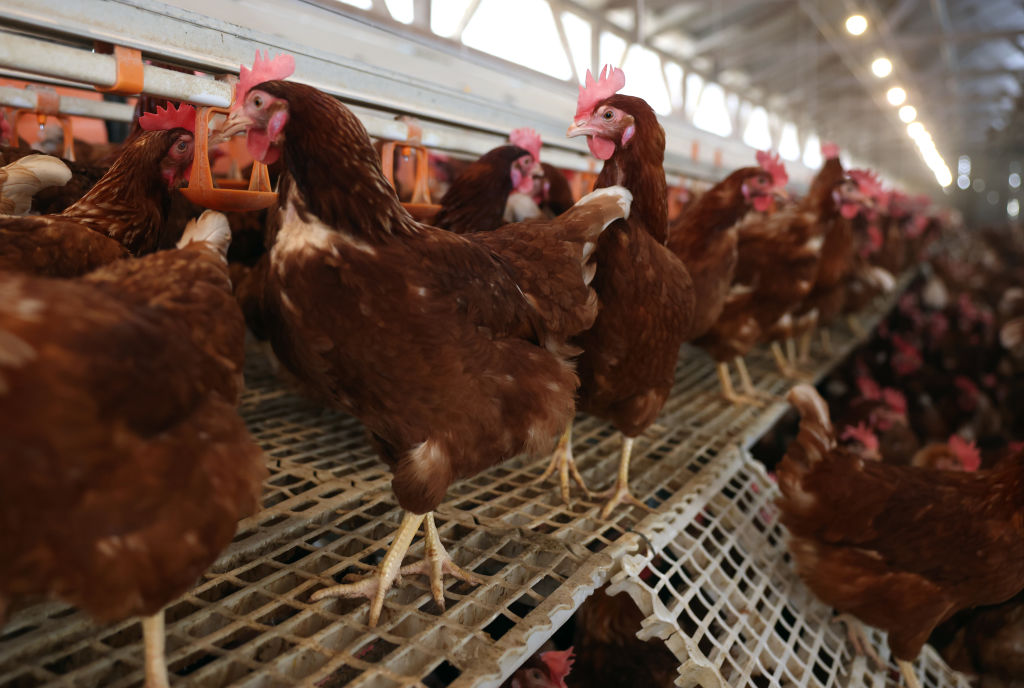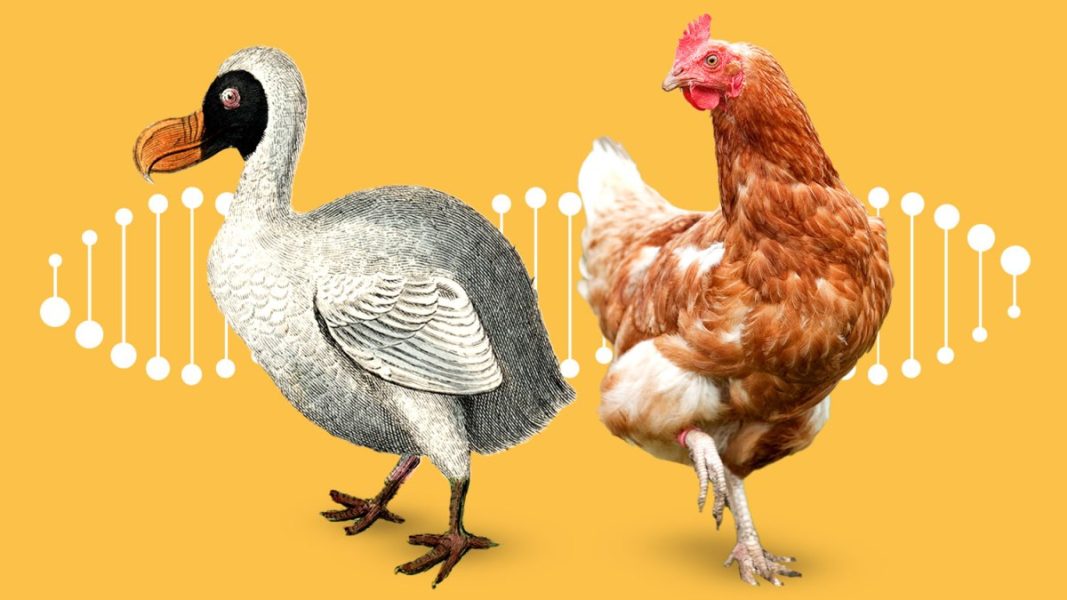Bird Flu Outbreak Continues to Spread – The Dispatch

PETALUMA, CALIFORNIA - FEBRUARY 18: Chickens stand in a henhouse at Sunrise Farms on February 18, 2025 in Petaluma, California. As egg prices continue to skyrocket due to the avian flu outbreak, egg farmers are having to invest millions of dollars in biosecurity efforts to keep their flocks safe. Fourth-generation egg farm Sunrise Farms in Petaluma, California lost 550,000 chickens to avian flu in December of 2023, marking the first time in 112 years that the main family farm had no chickens. It took Sunrise Farms over a year to rebuild their flock to 900,000 chickens that produce nearly 500,000 eggs a week. (Photo by Justin Sullivan/Getty Images)
‘What’s concerning is the spillover events to humans.’ Happy Wednesday! The owner of KFC recently announced plans to move the popular fast food chain’s headquarters from Louisville, Kentucky, to Plano, Texas. We’re all for low corporate taxes, but “TFC” just doesn’t have the same ring to it. When the January consumer price index report dropped last week, it came with more bad news for breakfast lovers: a record high for egg prices, which hit $4.95 for a dozen. Grocery stores across the country have begun imposing purchase limits, while criminals are carrying out egg heists. And according to our own Scott Lincicome’s totally scientific scale, we’re currently at EGGCON 3—not yet an egg-istential crisis but still concerning. The culprit? A now-yearslong outbreak of the H5N1 strain of avian influenza virus, which has forced farmers to kill tens of millions of infected and exposed birds. The flu made the jump to dairy cows last spring, and the first human death in the United States from the virus occurred last month.While health authorities maintain that the bird flu currently represents a low risk to people, researchers warn the extended duration of the outbreak increases the potential of the virus mutating and leading to widespread human-to-human transmission. Meanwhile, the Trump administration has signaled a forthcoming change in strategy as the government response thus far comes under fire. The H5N1 virus, which is most commonly found in birds, has circulated for decades since its discovery in 1996. The virus can spread via wild migratory flocks infected with the flu, making it challenging to contain. The virus has plagued commercial poultry farms since an outbreak in February 2022, and more than 159 million birds have died or been killed to stem the spread in the last three years. Poultry farmers across the country have been hit hard with many of them losing all of their flocks. The U.S. Department of Agriculture (USDA) compensates farmers for birds that are culled after an outbreak has been detected, but not those that have died from the virus—a policy intended to incentivize farmers to detect and report outbreaks as soon as possible. The bird flu can also infect wild mammals as wide-ranging as mountain lions and bottlenose dolphins, but the jump to dairy cows for the first time last year is particularly concerning to some researchers. More than 970 cow herds across 17 states have been infected with the virus. California, the nation’s largest milk producer, declared a state of emergency in December as roughly 70 percent of the state’s dairy herds contracted the virus. Infected dairy cows have a much lower mortality rate for the virus compared to chickens, but some cows experience reduced milk production even after recovering from the virus. Last April, the first known case of mammal-to-human transmission of H5N1 came from a person in Texas exposed to dairy cows presumed to be infected with the virus. “What’s concerning is the spillover events to humans,” Isaac Bogoch, a tropical disease doctor and researcher at the University of Toronto, told TMD. There have been 68 human cases of the virus so far, with the majority of them stemming from exposure to infected dairy cows and poultry. But a study from the Centers for Disease Control and Prevention (CDC) published Thursday and a previous study from August suggested that the number of human cases could be much higher due to insufficient testing and cases where individuals don’t experience noticeable symptoms. Between 2003 and January 2025, there have been 964 human cases in 24 countries, according to data from the World Health Organization. People can contract the virus when in close proximity to infected animals if the virus gets into their eyes, nose, or mouth—most human cases have experienced conjunctivitis, suggesting infection via the eyes. Very few of the confirmed human cases have resulted in serious illness. The woman who died in Louisiana was over 65 and had underlying medical conditions. A 13-year-old in Canada with mild asthma and obesity was hospitalized after contracting the virus last fall and nearly died, having to be intubated and placed on life support, before recovering sufficiently to be discharged in January. Last week, an elderly Wyoming woman became the third American case requiring hospitalization. The danger lies not in the virus as it is currently transmitted to humans but in potential mutations that could increase the virus’s transmissibility and virulence, threatening an epidemic or pandemic. Historically, human-to-human transmission of the virus has been limited, primarily occurring within households. So far, the transmission has not been efficient enough for sustained spread, and there have been no reported cases of human-to-human transmission in the current outbreak. But the longer the outbreak continues unchecked, particularly among mammals, the greater the risk of mutations that could result in sustained, human-to-human spread. During flu season, researchers are concerned about people and mammals contracting bird flu and other more transmissible types of the flu simultaneously. This creates the potential for viral reassortment, wherein H5N1 could take on some of the genetic features of another, more transmissible strain. This kind of reassortment in combination with the right mutations could result in elevated pandemic risk. The CDC’s guidance encourages farm workers to get the seasonal flu vaccine to reduce the chances of dual infections. “There’s significant uncertainty,” Bogoch said, “but there are arrows pointing in the direction that this certainly does have epidemic and pandemic potential.” Trump officials have criticized the previous administration’s response to the outbreak as ineffective and driving up egg prices. “They spent billions of dollars just randomly killing chickens within a perimeter where they found a sick chicken,” Kevin Hassett, the director of the National Economic Council, said in an interview Sunday. The response until now, while failing to stop the virus’ spread, has followed the USDA’s policy playbook of culling to contain. Some former public health officials and researchers have criticized the Biden administration for responding too slowly. Only in December did the USDA begin standing up a national dairy milk testing regime despite earlier signs of a lack of testing. Hassett outlined what appears to be the concept of a plan intended to reduce the number of chickens killed. “What we need to do is have better ways, with biosecurity and medication and so on, to make sure that the perimeter doesn’t have to kill the chickens,” he said. “Have a better, smarter perimeter. And so having a smart perimeter is what we’re working on, and we’re finalizing the ideas about how to do that with the best scientists in government.” It’s unclear what would be involved in “biosecurity and medication” or how the administration will approach the human epidemic risk of the virus. The egg industry has spent hundreds of millions of dollars on improved biosecurity, including investing in truck washing stations, bussing in workers to reduce foot traffic, and lighting systems that discourage waterfowl from landing, said Emily Metz, president and CEO of the American Egg Board. “All the measures we’re doing are still getting beat by this virus,” she added. Developing and deploying a bird flu vaccine for poultry is one idea that some industry representatives have begun expressing cautious interest in. Last week, the USDA issued a conditional license to the pharmaceutical company Zoetis for an update to its vaccine for use in chickens that was initially developed in the early 2000s. The government has maintained a stockpile of vaccines for use in chickens, but they are not fully updated for the strain of the current outbreak. In the final weeks of the Biden administration, the USDA announced it was moving to update the stockpile but had not made a broader policy shift away from a culling to a vaccination response. But assuming the newer vaccines are effective, some virologists argue vaccinations aren’t necessarily a silver bullet as they don’t prevent infection and would need to be deployed strategically as one piece of a broader eradication effort.The president has reportedly tapped Gerald Parker, a veterinarian and a former senior public health and biosecurity official, to lead the White House Office of Pandemic Preparedness. Dr. Ashish Jha, the former White House COVID-19 response coordinator in the Biden administration, described Parker as “a very good choice” and “deeply knowledgeable, serious, not particularly partisan, but really just very focused on important issues.” But the Trump administration’s early steps appear to have at least partially hampered the outbreak response. The freeze on communications from public health agencies, including the CDC and the USDA, left state health officials and researchers working on the virus confused and isolated as meetings were canceled and regular reports on the course of the outbreak withheld. The USDA also admitted Tuesday that it accidentally fired employees working on the virus response that they’re now trying to rehire, and a quarter of the staff in the USDA’s National Animal Health Laboratory Network’s program office has been let go. The office manages data and coordination across the labs doing animal testing including those working on the bird flu—labs were notified Friday that H5N1 testing would be slower following the firings. While there’s no way to confidently predict whether the bird flu will become a serious threat to humans, more scientists have grown concerned with how long the outbreak has dragged on. “Some people might say, ‘Well, you know what, if we’re going to have an epidemic or a pandemic wouldn’t we have seen it by now?” Bogoch told TMD. “And the answer is, maybe, maybe not, but, the costs of being wrong are pretty catastrophic.”New York Times: Bannon Calls Musk a ‘Parasitic Illegal Immigrant’NBC News: Trump Says Ukraine ‘Should Have Never Started It’ in Comments About War With RussiaAlmost exactly 56 years ago to the day, Johnny Cash and Bob Dylan met in Nashville, Tennessee, to record a duet of “Girl from the North Country.” We personally think the harmonies make it the best version of the iconic song. What’s your favorite overlooked modern luxury?
Charlotte Lawson is the editor of The Morning Dispatch and currently based in Tel Aviv, Israel. Prior to joining the company in 2020, she studied history and global security at the University of Virginia. When Charlotte is not keeping up with foreign policy and world affairs, she is probably trying to hone her photography skills.
Grayson Logue is the deputy editor of The Morning Dispatch and is based in Philadelphia, Pennsylvania. Prior to joining the company in 2023, he worked in political risk consulting, helping advise Fortune 50 companies. He was also an assistant editor at Providence Magazine and is a graduate student at the University of Edinburgh, pursuing a Master’s degree in history. When Grayson is not helping write The Morning Dispatch, he is probably working hard to reduce the number of balls he loses on the golf course.
James P. Sutton is a Morning Dispatch Reporter, based in Washington D.C. Prior to joining the company in 2024, he most recently graduated from University of Oxford with a Master’s degree in history. He has also taught high school history in suburban Philadelphia, and interned at National Review and the Foreign Policy Research Institute. When not writing for The Morning Dispatch, he is probably playing racquet sports, reading a history book, or rooting for Bay Area sports teams.
Cole Murphy is a Morning Dispatch Reporter based in Atlanta. Prior to joining the company in 2025, he interned at The Dispatch and worked in business strategy at Home Depot. When Cole is not conributing to TMD, he is probably seeing a movie, listening to indie country music, or having his heart broken by Atlanta sports teams. Your membership includes the ability to share articles
with friends. Share this article with a friend by clicking the button below.Please note that we at The Dispatch hold ourselves, our work, and our commenters to a higher standard than other places on the internet. We welcome comments that foster genuine debate or discussion—including comments critical of us or our work—but responses that include ad hominem attacks on fellow Dispatch members or are intended to stoke fear and anger may be moderated.With your membership, you only have the ability to comment on The Morning Dispatch articles. Consider upgrading to join the conversation everywhere.You’re in! You’ll start receiving our flagship newsletters.Use the options
below to copy or email a special link so that friends or family can access this article without a
subscription.
Source: https://thedispatch.com/newsletter/morning/bird-flu-outbreak-continues-to-spread/






